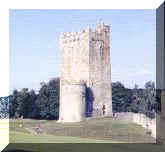
The lovely castle and grounds of Drishane are situated a mile to the northeast of Millstreet, near where the Finnow river joins the Blackwater.
The castle sits on an elevated limestone rock. It is in fine condition and consists of a tower house and a small circular tower/turret. The tower stands at 22m (72ft) tall, 9m wide and 8m deep. It is built of stone, has internal timber floors, and a slate roof on top. The four storeys are reached by a narrow circular stone staircase. The lower windows are narrow arrow-slits which were for defensive purposes. There are “Irish” crenelations on the roof. There is a smaller circular tower/turret next to the castle which would have been for defensive purposes.
The castle was built by the MacCarthys and the date given for its construction varies between 1436 and 1450
It seems likely that it was commenced by Dermot Mór, the second son of Teige the 3rd Lord of Muskerry, who was a direct descendant of Diarmuid, King of Cork. Dermot also is said to have built Kilmeedy and Carrigaphooca in the great period in which his brother, Cormac Láidir, was building Blarney and Kilcrea. Dermot died in 1448 and Drishane was probably completed by his son, another Dermot.
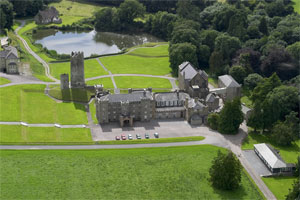
The denealogy for the MacCarthy family in general is confusing, particularly since Christian names are so often repeated, but the account of the Drishane branch varies considerably in differing renderings. For instance it is several times stated that there were two centenaries in the family, both named Donogh. From a study of the documentation available – admittedly scanty at times – it seems likely that there may have been only one: the second Donogh, who is buried in the castle grounds and lived 1597 1719 to an age of 122 years.
Some authorities state that the first Donagh lived from 1517 – 1639. Documentation clearly shows that Teige, son of Owen was in possession of the property in 1592 when he surrendered it to the Queen and got a re-grant. If Donagh was still alive he would, probably at least, have been the property owner.
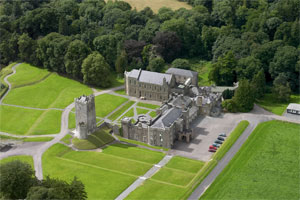
Teige died before 1624, when there was an inquisition on his lands, and in a further inquisition of 1638, his son Owen Mac Teige is described as being in possession of Drishane Castle at his death in 1637. The latter’s son, Donogh MacOwen, the centenarian, inherited. He was over 40 at the time (which would confirm a birth date of 1597) and had married Kathleen Fitzgerald, who also died in 1637. It would appear from other information that he married a second time.
Owen had brothers named Callaghan, Donogh and Phelim (on whom I have little information) as well as Dermot who was killed leading a squadron of horse at the battle of Knockbrack in 1652 – the end of resistance to the Parliament in the area. Donogh mortgaged Carriphooca to Dominic Coppinger before 1641 – probably to raise funds for the Confederate War.
All MacCarthy lands were finally forfeited at the end of this tragic period, but were restored to Donough MacCarty, the first Earl of Clancarty, overall head of the family, on the restoration of Charles 11 in 1660. He granted a lease in 1677 to Donogh: and this lease was passed with the proviso that Donogh settled what was due to Coppinger.
The MacCarthy lands were finally forfeited following the Jacobite period of 1690 and Drishane fell into the hands of the Hollow Sword Blade Company, an organisation which had financed William’s campaign in Ireland. In 1709 they sold to Henry Wallis of Ballyduff, Co Waterford, a younger son of Thomas of Curraglass (Mogeely), where the family had been resident since 1596.
There is some doubt also about the date of the first connection of Wallis with Drishane. Renovations were carried out at the castle in 1643 according to the date on a fireplace, and this bears the inscription “W” suggesting “Wallis”.
It is further suggested that Wallis shared a friendship with Donagh MacCarthy, and that he allowed the latter to live in peace at Drishane during his lifetime. Another account states that Donogh demised part of the land to Henry Wallis; and after Donogh eventually died in 1719 his widow, in 1722 and 1724, leased her interest in the remaining lands to Thomas Wallis, son of Henry.
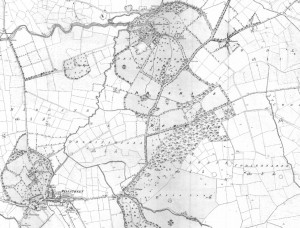
The Wallis’ turned Protestant converted to the Church of England and ‘discovered ‘ the property under the Property Act and so purchased what remained of Drishane for £450 (it was valued at £8000) in 1798. This led to a horrendous local tradition that Donogh’s widow died on the doorstep of the castle from exposure, but in reality (since the exchange of cash was involved) the transaction may have been to clarify the entire matter because of claims being made by the widow’s relatives, the O’Learys, to the property.
By the time Doctor Smith wrote his History of Cork in 1750 he was recording that there as a handsome new house near the castle built by the late William Wallis who had considerably improved this part of the country, by manuring it with lime, enclosing planting etc.
In fact the Wallis’ appear to have been popular in the neighbourhood and remained there until 1882 when the estate was placed in Chancery on an application of insurance companies, and there it remained until 1908 when it was sold in 1908 before Judge Roy to Patrick Stack of Fermoy from whom, through the offices of Cornelius Duggan of Cork. Soon after it was passed to the Dames of Saint Maud, a French order of teaching nuns ( The Congregation of the Holy Child Jesus) in 1909.
When the Drishane Sisters came to Drishane they remained there until c.1992 when the Estate was purchased by the Duggan Family. Initially a hotel was envisaged. The Kosovar people stayed there for a year. Since 1999 it has been a reception centre for asylum seekers coming to Ireland as part of the Direct Provision system. It houses mostly families, about 200 people in total.
The lands and estate while being farmed have become a top international cross-country course for horses.
THE PROPERTY IS OPEN TO THE PUBLIC on Appointment only. Contact by <email>
Architecturally
Tower House: Now standing at south end of Drishane House (see below); built directly on rock outcrop. Rectangular 5-storey tower with adjacent circular 2-storey tower. Structures were ‘completely restored some time post 1879’ (Bence-Jones 1988, 108), and again repaired in more recent times; repairs include battlements atop both structures, all wooden door and window frames, stone flagged floors, wooden floors over main ground- and 1st-floor chambers of rectangular tower, and slate roofs.
Rectangular tower (8.8m E-W; 7.7m N-S), with slightly rounded corners; entered at ground-floor level through door near N end of E wall, door surround has been re-set. Short lobby inside has door on W side, with pointed arch, giving access to main ground-floor chamber, and similar door on S side, leading to mural stairs which rise to SE corner of tower, where they continue upwards as spiral, giving access to main 1st-, 2nd-and 4th-floor chambers, and to two mural garderobe chambers in E wall at 1st/2nd and 3rd/4th floor levels.
Ground-floor chamber (4.85m E-W; 3.85m N-S) lit by windows in centre of S wall and at W end of N wall; both have square-set embrasures covered by segmental vaults. First-floor chamber (5.2m E-W; 3.9m N-S) entered via short L-shaped lintelled passage from spiral stairs; chamber lit by roughly-central windows in S, W and N walls; these have splayed and lintelled embrasures and single square-headed lights. Main second-floor chamber entered directly from spiral stairs, through door with pointed arch, in SE corner of room; lit by roughly-central windows in S, W and N walls, similar to those on 1st floor but with single ogee-headed lights. Third floor is attic under pointed wicker-centered vault (axis E-W); lit by single window in W wall; embrasure similar to those of floor below but with single flat-headed light; original entrance to this floor probably via manhole from floor below. Main fourth-floor chamber entered, via short passage from top of spiral stairs, through door on S side of deep window embrasure in centre of E wall; embrasure is square-set, covered by segmental vault, with double ogee-headed light; similar window embrasure in centre of S wall. Spandrels of latter window light are decorated with simple geometric design; light covered by hood moulding, with stepped terminals, which is flanked by two carved human heads. There are also windows in centre of N and W walls, similar to those on 2nd floor. Opposite entrance door, in N side of E window embrasure, is door leading to spiralstairs in NE corner of tower, which rise to wall-walk level.
At 1st/2nd floor level lintelled door on N side of spiral stairs gives access to lintelled passage (4.7m N-S; 1.1m E-W) with garderobe at N end; lit by two slit windows in E wall. Second mural passage in E wall at 3rd/4th floor level; entered through door, with pointed arch, on N side of spiral stairs; lintelled passage (3.5m N-S; 0.9m E-W) leads to SE corner of tower where it turns at right angle to W (L 1.1m), at W end of latter section is garderobe opening; passage lit by single slit windows in E and S walls.
Circular tower (int. diam. 2.9m; wall thickness c. 0.9m) just 0.9m S of SE corner of rectangular tower, and projecting 1.3m beyond its E wall; now free standing but originally linked to tower by straight wall. Entered on NW side through repaired ground-floor door; gun loop on E side of door, also gun loops facing S and W. Inserted window on SW side and inserted fireplace to SE. First floor has door ope to NNE, window ope to NE, traces of fireplace to E and splayed ope, possibly gun loop, to SE; modern roof overhead.
Mac Carthy castle; built, according to tradition, in 1450 (Lee 1914,64), a date not inconsistent with present tower. Circular turret is later, probably added in late 16th/early 17th century to allow for flanking fire by defenders. Adjacent house built by Wallis family in 18th century but enlarged and castellated in mid-19th century (Bence-Jones, ibid.); later a convent school, now in private ownership.
The above description is derived from the published ‘Archaeological Inventory of County Cork. Volume 3: Mid Cork’ (Dublin: Stationery Office, 1997). [ref]
Photos of Drishane
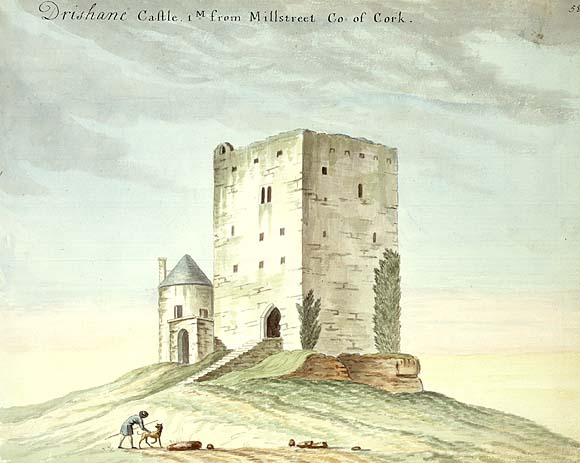
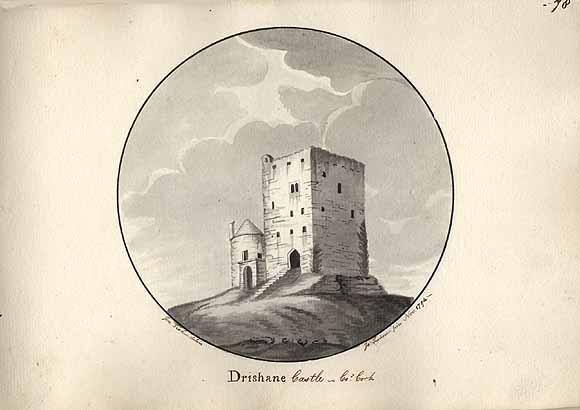
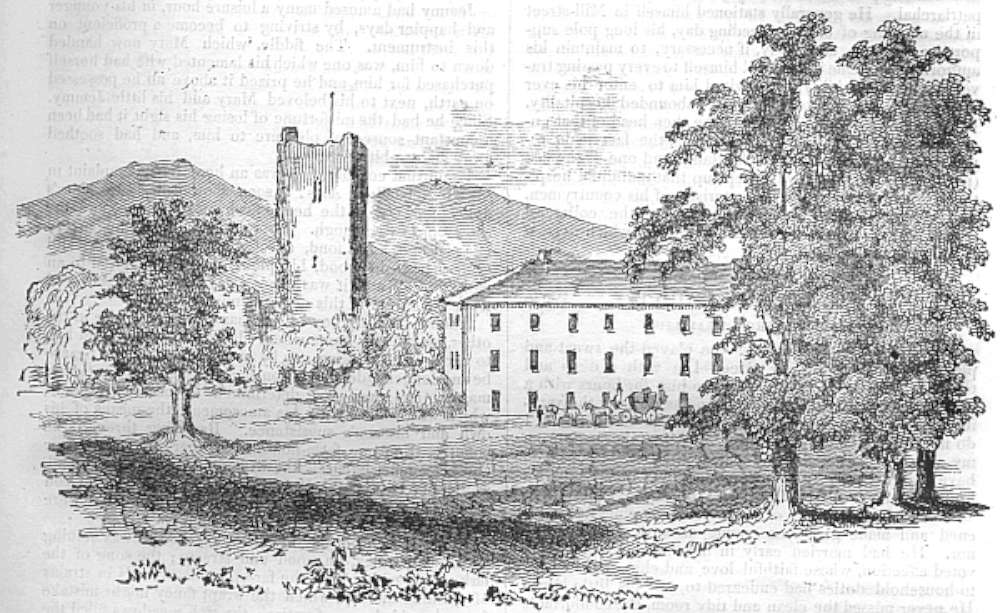
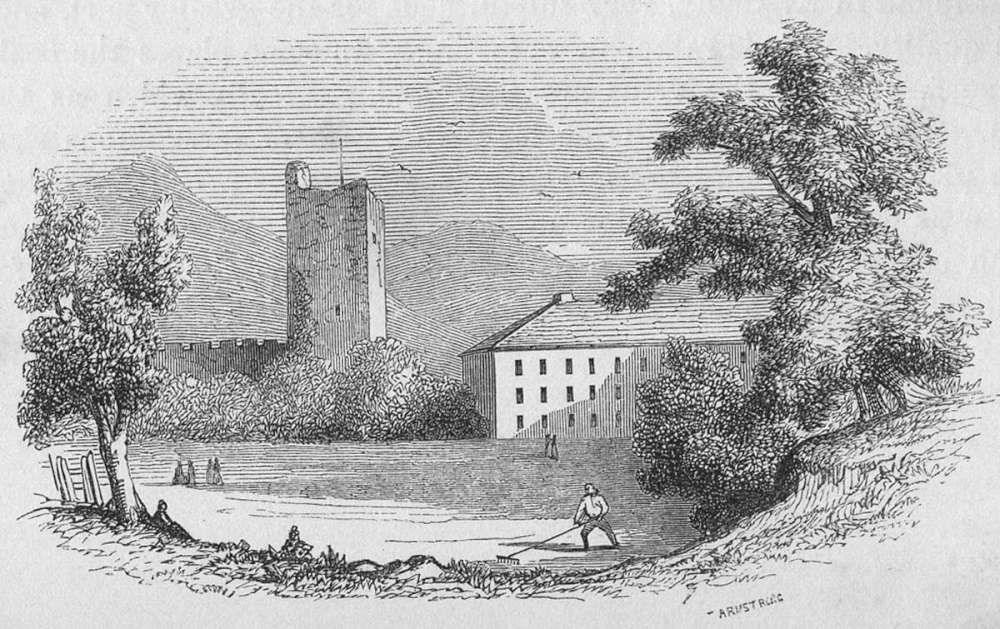
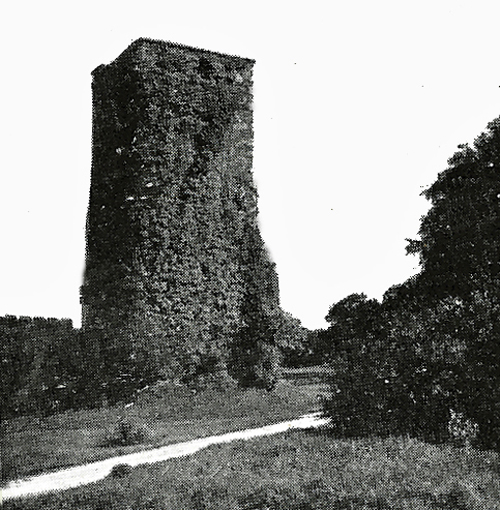
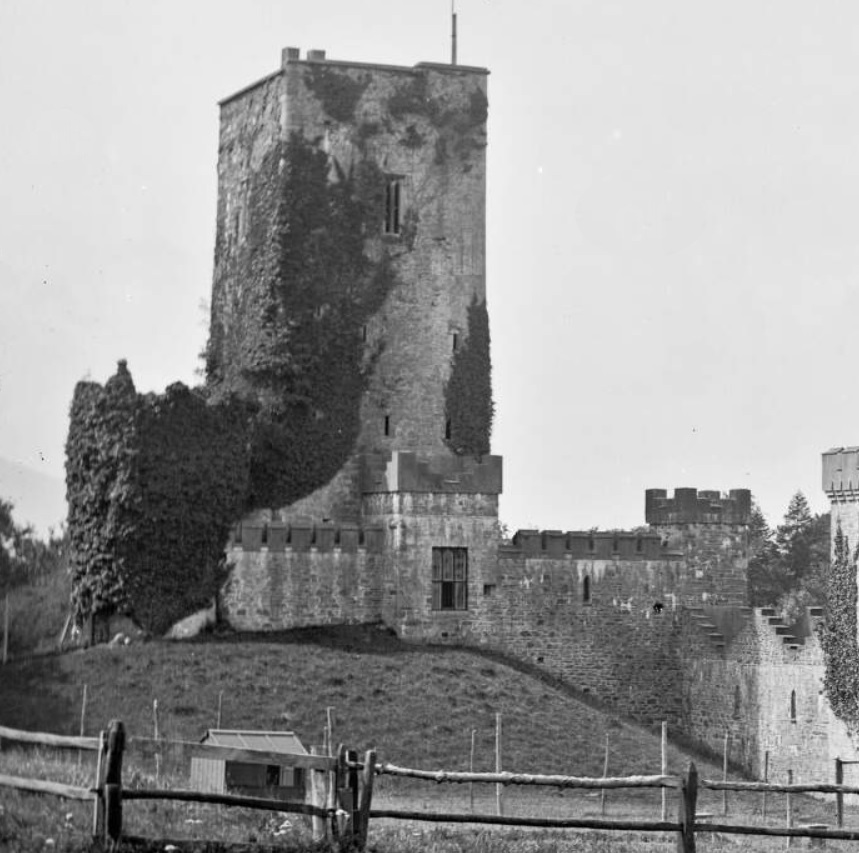 Drishane Castle from the Eblala Collection (1870-1890). The same photo, but with a different number is listed as being in the Lawrence Collection.
Drishane Castle from the Eblala Collection (1870-1890). The same photo, but with a different number is listed as being in the Lawrence Collection.

Drishane Castle – western side, taken about 1909. (see also similar images from 1909 and 1907). This photo is interesting because it shows the following:
- It had just been sold to the nuns (statue of Holy Mary in another part of the image).
- The towers were nearly covered in ivy after a long period of neglect.
- The castle has no crenelations at this point! They still hadn’t been added by the 1966 (see the harp photo below), but are there by 1974 for the filming of the movie – In This House of Brede [2]. It turns out that they were added in the early 70’s by the Board of Works, when other maintenance work was also carried out (see the Architecturally section above for details)
- If you look to the top of the castle, are they two chimneys on the north-east (nearest) corner?
- Protecting the door of the castle appear to be battlements. This was actually a corridor that connected the house and the castle. This section had been built in the 1870’s – at the same time as other extensive works on the house. It was mostly removed 1989. See more details on it here (TODO: add link when article is published)

Drishane Castle – western side, taken about 1909 from where the chapel was later built. Note. the earth at the base of the tower was removed in later years. Was this to prevent ivy and other creepers from growing again?
 From the growth of the ivy, we would say that this photo was taken in the early 1910’s, not long after the Lawrence photo directly above it. Again no chapel which would have appeared on the left [1]
From the growth of the ivy, we would say that this photo was taken in the early 1910’s, not long after the Lawrence photo directly above it. Again no chapel which would have appeared on the left [1]
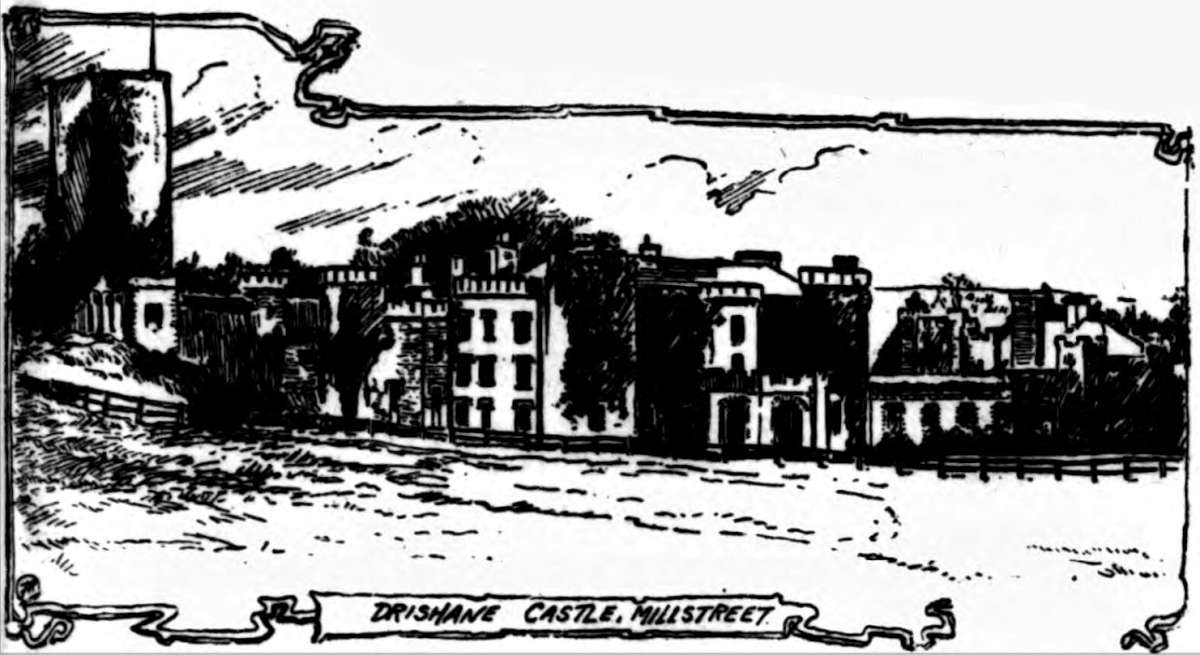
A drawing of Drishane that appeared in the Irish Independent of Thursday 26 November 1908, attached to an article that the Infant Jesus Sisters had purchased it and were to set up a convent there
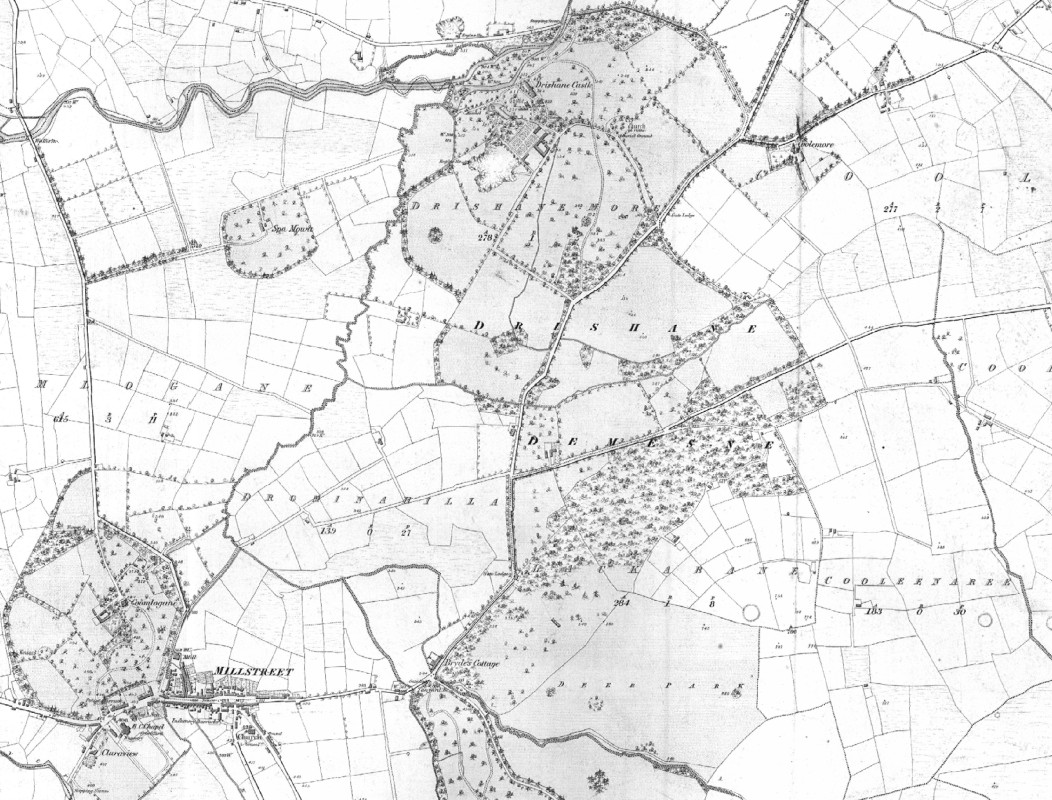

Drishane Castle in 1990, when the Lawrence photos were being recreated.
Drishane Castle in 2005
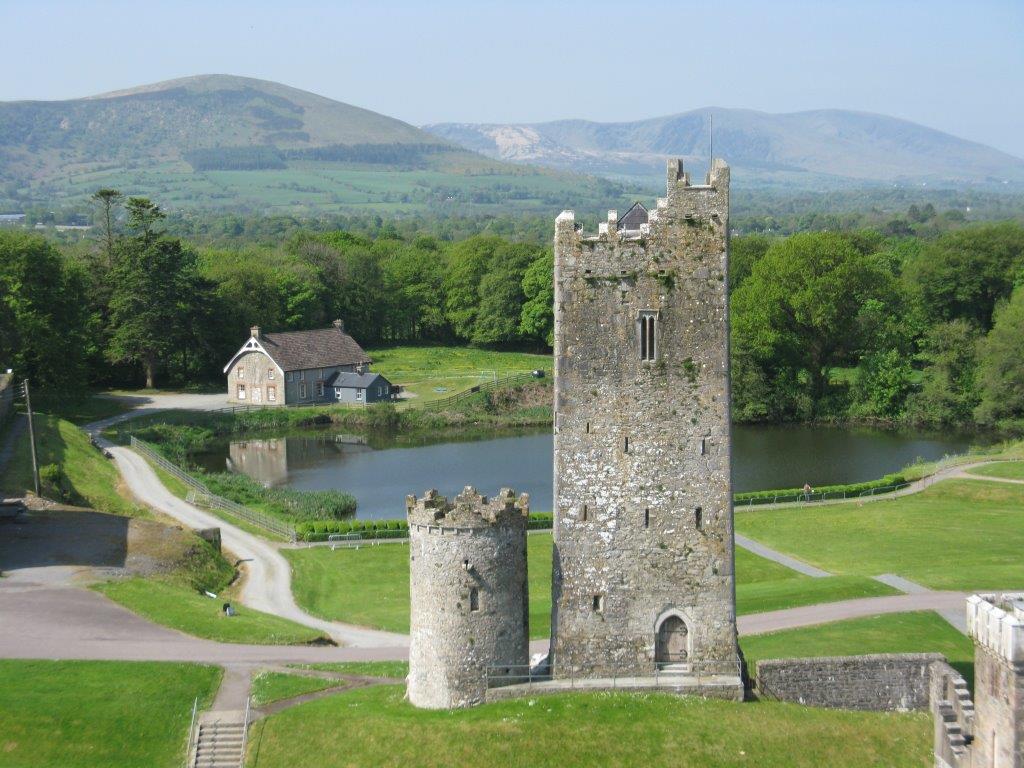
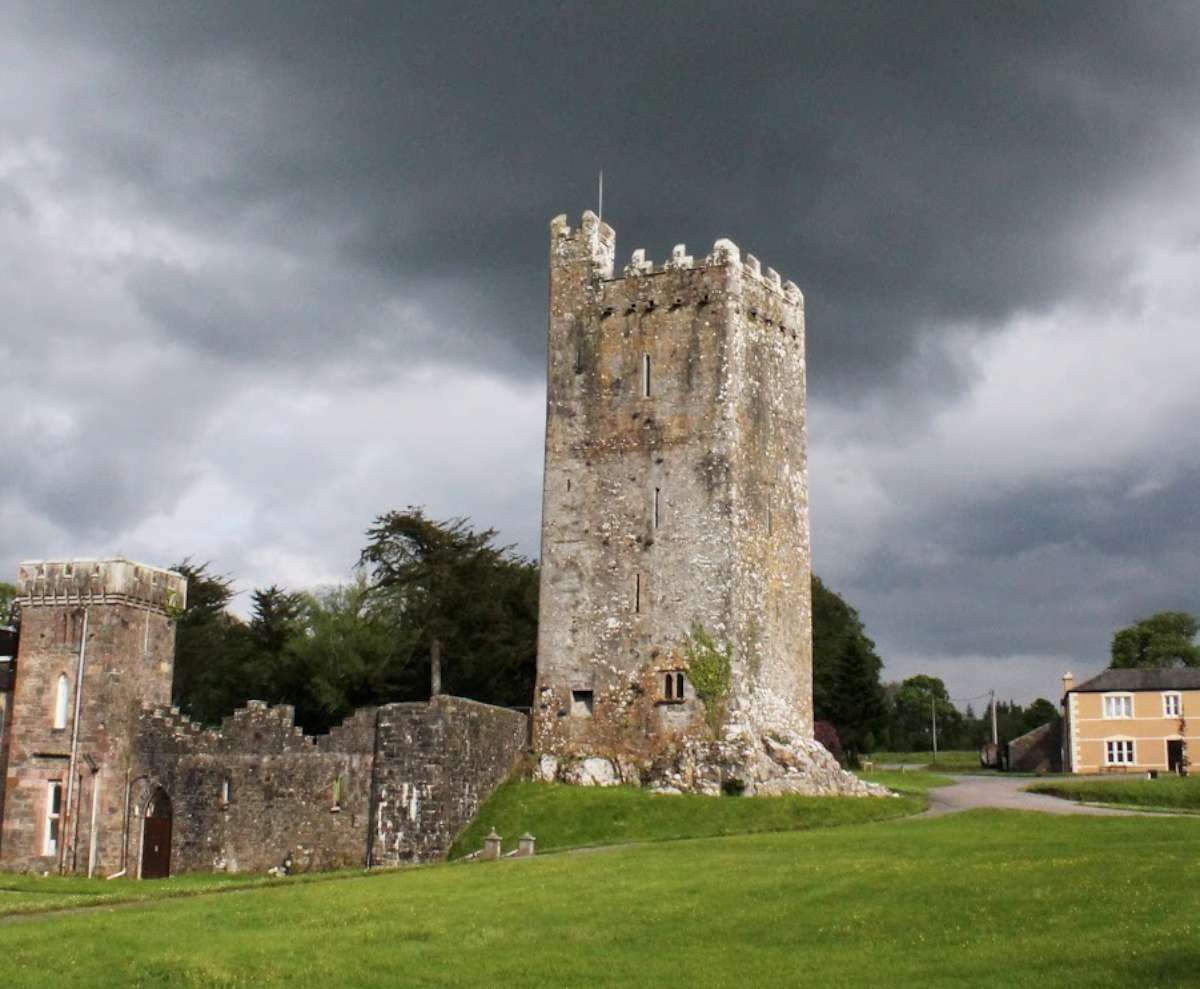 2012: From the eastern side. The small square opening at the bottom left corner of the castle looks like the toilet (garderobe).
2012: From the eastern side. The small square opening at the bottom left corner of the castle looks like the toilet (garderobe).
An interesting video showing the Drishane Castle and estate [2017]
Inside the castle
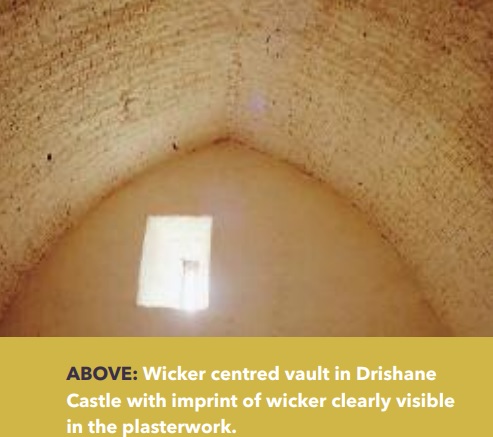
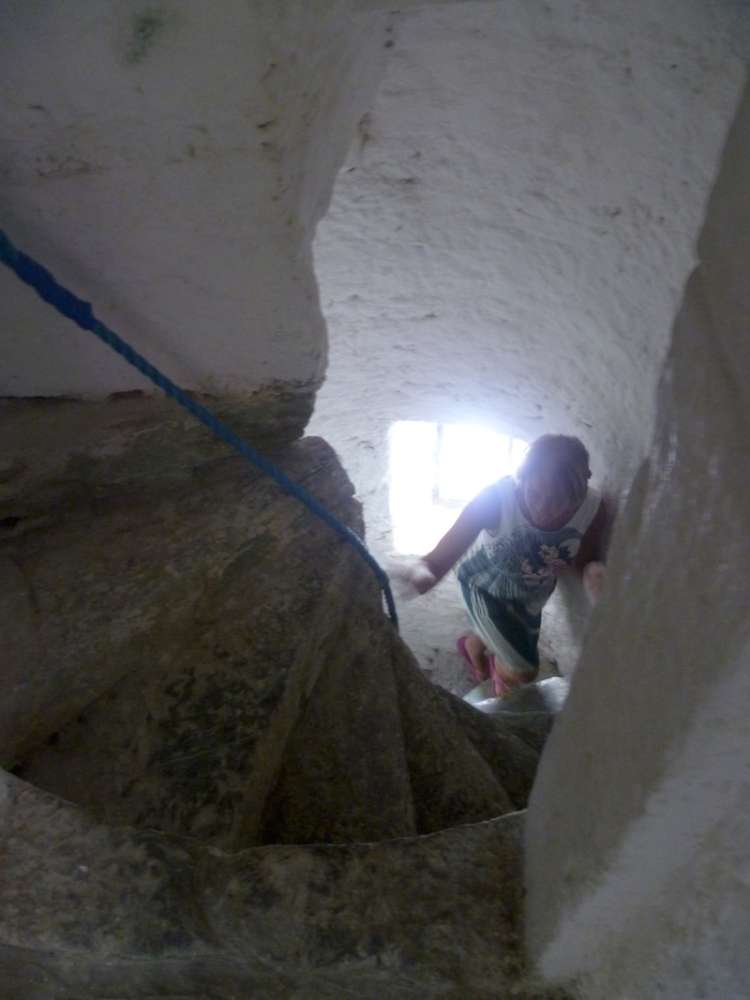
The internal staircase in Drishane Castle [2013]
 On the roof of the castle – showing the internal slate roof, the crenelations, and the flagpole (north west corner) [2013]
On the roof of the castle – showing the internal slate roof, the crenelations, and the flagpole (north west corner) [2013]
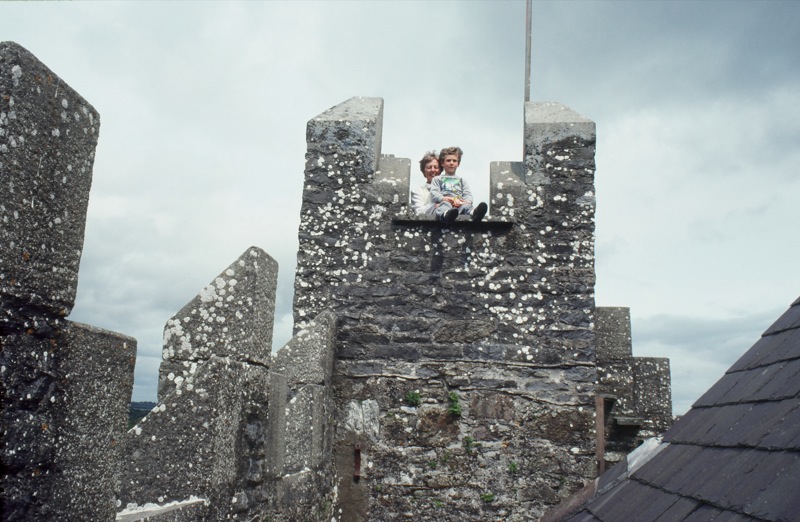 The highest point on top of the castle (1989). Note from this photo are:
The highest point on top of the castle (1989). Note from this photo are:
1. The difference in the brickwork, the top section dates from about 1970, whereas the lower section presumably dates from around 1450.
2. The steep pitch of the slate roof. In the 1950’s, the roof was actually flat (from Tim O’Shea). What was the flay roof made of? Were there leakage problems? The slate roof put at the same time as the crenelations during refurbishment work by the Board of Works around 1970.
3. The stone steps embedded in the castle walls (bottom right) that lead to this upper level. The steps can also be seen here, and in the film – In This House of Brede
4. The location of the flagpole at the highest point. it is now back down in the corner below where the child is sitting – where the metal bracket is on the wall – was this bracket for supporting a flagpole previous to that?
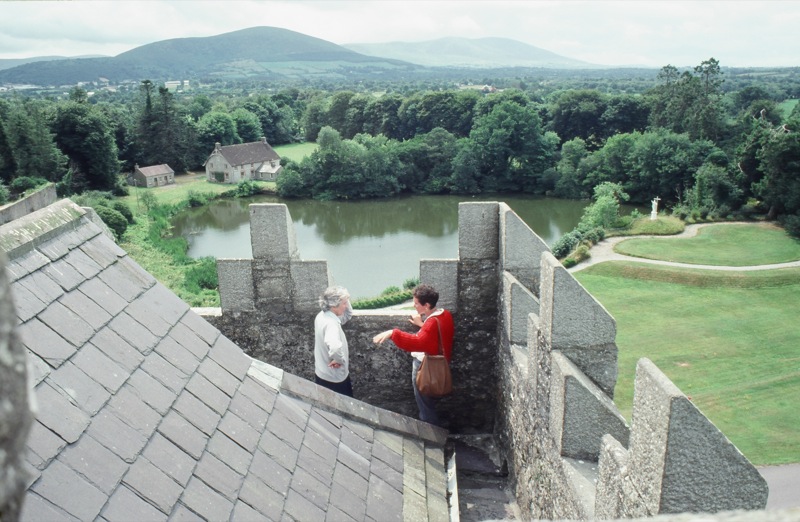 From the highest point on top of the castle (1989), looking down on the lake and the Knitting School.
From the highest point on top of the castle (1989), looking down on the lake and the Knitting School.
TODO: was there a separate door to the castle – facing the round turret -as seen in this photo here.
**********
This article is about the Castle only. The House, Convent, and Chapel are dealt with in different articles (TODO: link to them)

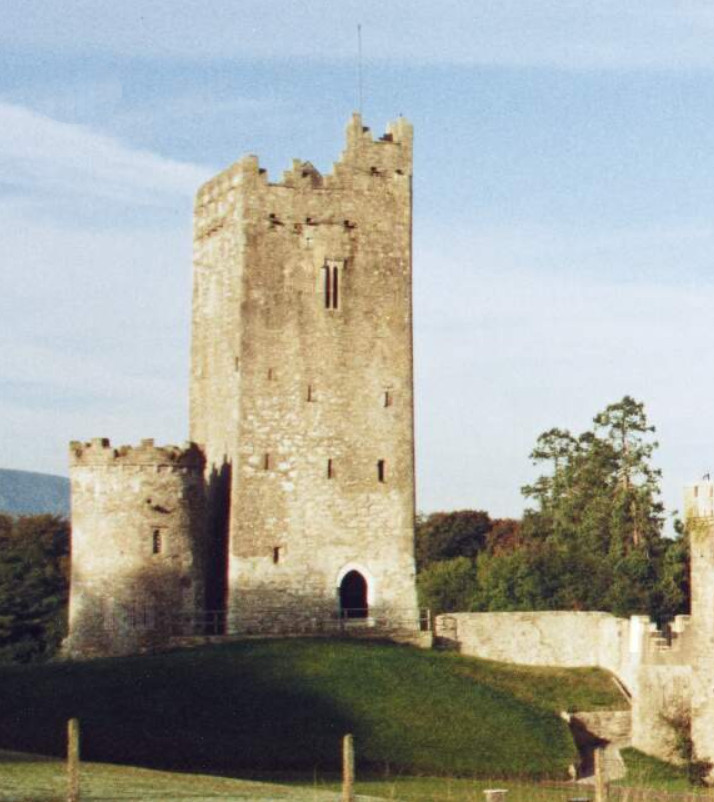
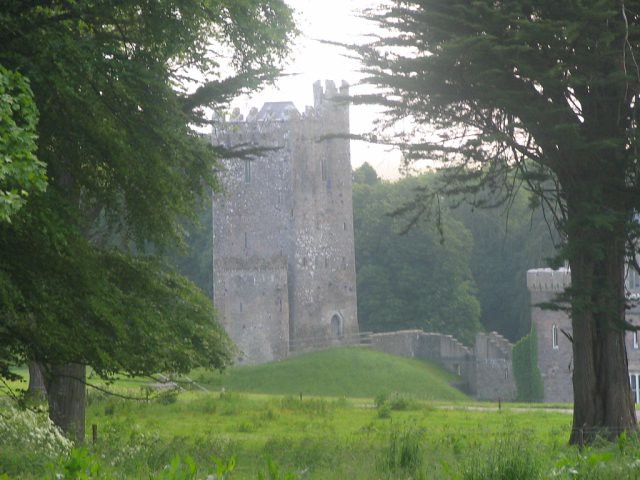
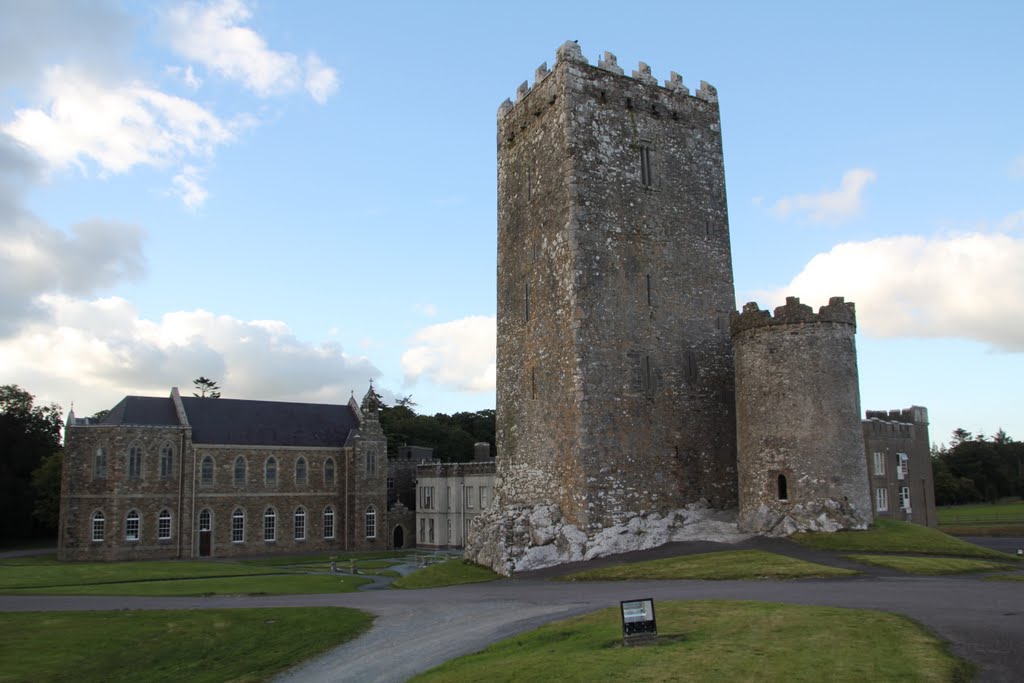
I am researching battlements for a proposed restoration of a tower house near Cobh and wonder if I might be able to access Drishane’s roof in order to measure the battlements?
I would be very grateful.
Kind regards,
Bena Stutchbury – 087 258 1844
Dear Sir/Madam,
Late last year, you permitted me to closely inspect and tour the ‘Keep Tower’. It was fasinating and I photographed it thoroughly. It is on a line of my family’s history as a home and it was a powerful emotional experience to be there. I had come from Australia it see it, and the Drishane Cemetery graves, Kilcrea Friary, it and other family history sights. Thank you for care and interest. Hunter Gill (Great Grandmother – Isabella McCarthy).
When visiting our ancestral home,the Drishane Keep, we ventured over to the Drishane Cemetery on the edge of the estate and found ancestors from up to 700 years ago. I am concerned about the sizable tree growing inside the elevated grave. I will split the ancient Cormac McCarthy grave. Could this tree be poisoned and removed please? Maybe this has already being done? Descendant of Cormac McCarthy; Hunter Gill.
Hunter, I have speculated whether my great-great-grandmother Grace Fitzell, nee McCarthy 1802-1876 who was living at Millstreet from at least 1826-1853, is descended from the McCarthy family of Drishane Castle. If you are interested to discuss, please email me at <email>. Thanks. Jean, also from Australia
Hi, my name is Timothy McCarthy and my ancestry on the McCarthy side is close to Millstreet/Drishane. I was just wondering if there might be a family connection between us? My family tree is public on Ancestry and I have done a DNA test with them.
Kind regards,
Tim
In apprx 1963 when I was 7yr old child my father was carrying out some work on the Convent relating to woodworm/dry rot, the firm he worked for was called Biotox.
Anyway my family were from Dublin and my dad arranged for my Mother myself and sister who was a few years older than me to stay in one of the groundsmen’s cottages with the family.
The cottage if I can recall correctly was at the end of a lane which led to the convent,there was a lad from the cottage apprx the same age as myself maybe a bit older and we spent a lot of time fishing in the lake on the convent ground’s.
I often think of that childhood Holiday and have to say was one of the best of my life,we would walk to the cinema in Millstreet in the evening and always run home at full speed past the graveyard.
I often wondered what had become of the Convent, my dad had told me f a Lion or Tiger that was in the main hall, I don’t know if he was adding his ‘own bit on’ but said to have been shot by one of the nun’s years previously in some far off land where they had served..was wondering could anyone add to this ?
Hello Donal,
Thomas Duggan here – Drishane is now in our ownership (for the past 24 years in fact). The tiger is still in Millstreet but now in the Green Glens Arena, and yes he was shot on the grounds of a House of the Sisters in Malaysia once upon a time. My sisters went to boarding school there and I recall from a very early age the tiger in the hall – he was very scary looking.
Drishane is currently accommodating Asylum Seekers and has been doing so since August 1998. It is a lovely place and is full of history with its connections with the past.
The good news is that the work your Dad did worked ! There is no rot there now.
The cottage you refer to is no longer there, it suffered a fire in its latter years and then was knocked.
If you would like to walk down memory lane anytime in the future please feel free to do so, you will be very welcome.
Best regards,
Thomas Duggan
Hello Thomas! I went to school in Drishane with your sister Regina. Happy to see your family is taking care of the place. I have very fond memories of my days in Drishane.
Cathy (O’Malley) Kollai
Tennessee,USA
Hi Donal,
The family your dad stayed with were the McSweeneys,
They lived in the lodge as you go down to the graveyard
They had two in family Terence and Mary.
I do remember as i was young at the time
If you want any more info do contact me
Regards Neil Cronin
Dear Donal,
We are the same age. My grandfather worked for the nuns foe many years and because of that my brother and I were allowed to fish the 2 ponds during the holidays for many years starting around 1964. Do you remember sisters Ambrose and Aloysious? The latter was the terror of Drishane when she was driving the other nuns in the Ford Cortina. She was lovely.
I know your comment is many years old but Im still hoping you get mine.
Kind regards to all the people on this forum,
Allan Dennehy
Hi! I am a McCarthy from Argentina. James McCarthy (b.1836 in England), son of Callaghan McCarthy (Millstreet, Cork County, Ireland) came to this country with his sons (Augustus Charles McCarthy my old grand father). It´s a pleasure for me to research all about my ancetors and I hope I will be visiting the castles and finding my roots and familiy for 2017.I like very much this page. Thank you!
Hi, My mother was a Wallis, daughter of James Harold Wallis who is a direct descendant of the Wallis’ of Dishane. When I was a child my mother used to wax lyrical about the ‘Family Castle’ but reading the history here the Wallis’ claim on Drishane seems rather short-lived. Could you tell me how I might find out more about the Wallis’ contribution to the Castle?
Thanks
James Gilbert
The Aubane Historical Society booklets have bits and pieces on the Wallis family of Drishane, as do lots of other pages on the internet. The below link lists out where they are mentioned:
https://goo.gl/53QVP5
Though I haven’t read it, there’s also a three page article in the 1962 “Journal of the Cork Historical and Archaeological Society” on the Wallis Family of Drishane, that might be a good place to look:
The Wallis family of Drishane.
Main Author: Wallis, Sheila
Citation: Journal of the Cork Historical and Archaeological Society , Vol. LXVI, pp. 48-50, January-June, 1962
Format: Journal Article
Published: January-June, 1962
It can be viewed in the National Library of Ireland (details: http://sources.nli.ie/Record/PS_UR_096043),
or that back edition can be purchased from the Cork Historical and Archaeological Society for €12.50, details on their website corkhist.ie/journal/ under “Purchasing Back Issues and Indexes”.
My name is Jade Wallis, grand daughter of Pauline Wallis( daughter of Thomas Wallis and direct descendant of Henry Wallis). I would love to visit the castle. I live in the Caribbean it would be fascinating to find out where all Henry’s descendants now reside, all over the world I bet!
Hello there – my name is Pamela King and I am the great great grand-daughter of Richard and Mary Barker of Moorlinch in Somerset – – Mary was formerly Mary Wallis from Midelney in Somerset, a direct descendant of the Wallis family from Drishane in Cork – Mary’s neice married her husband’s son, Percival Barker and Mathilda and Percival are my great grandparents – they emigrated to New Zealand in the 1870’s and within 25 years, Percival had amassed over 80,000 acres of land on the East Coast of NZ’s North Island – they had 14 children, 7 sons and 7 daughters, their eldest son Frank was my Grandfather. Of real interest to me was the names of various of the brothers’ lovely homes including one called Midelney and one called Drishane – in my research for a book of my Barker family history, I finally found/recognised this link to the Wallis castle in Cork, Eire – I intend visiting Castle Drishane in May of this year – Cheers
Hi Pamela,
It’s interesting to make the connections, but the wallis family spread far and wide going back the generations, but then mostly seemed to have died out over here. We have some more information on them here:
http://www.millstreet.ie/blog/2016/04/03/irish-divorce-suit-what-happened-in-a-flat
I wonder if you ever stumbled across the name Henry Digby Wallis from your records in NZ, or even his father Henry Aubrey Wallis? Digby was of the last of the Wallis family of Drishane, was born in Auckland in 1885 … but was killed in 1914 in WWI.
Hello there Michael – many, many thanks for all the wonderful ‘stories’ and factual info you posted to me in reply to my post – I’ve loved reading through it all – [cannot work out the ‘Wallis’ connection in the race day pics though] -sadly, I know nothing of the Henry Digby Wallis you mention as having been born in and presumably spent time in Auckland – again, many thanks for your reply post – so interesting and showing the family to have been a fabulously irrepressible and colourful lot – Love it! I do still believe there must have been some connection to the Drishane Wallis family, given the names of two of the Barker family properties here in NZ – Cheers and please keep on researching! Pamela
Hi, I went to school at Drishane Convent which was then a boarding school. I was wondering if you have had any past pupils contact your website? and if you could put me in touch with any past pupils, particularly the class of 1973?
This post concerns photos I possess of Drishane , includes boarders and nuns , from 1924. My aunts attended during the 1920’s. As it happens they were McCarthys. My query really are photos from 1929 showing a hockey team visiting Kilrush Co.Clare and whether they depict a convent team. Does anyone know if hockey was a sport there in the 1920’s.
Any pointers / help would be gratefully received.
Anthony McCarthy.
Dear Anthony,
Unfortunately I cannot help you much regarding whether hockey was an active sport in Drishane in the 1920s, but i the photos are taken in Drishane at that time I would love to have a copy. We have a number of shots from different periods all of which reveal their own stories.
Sincerely,
Thomas Duggan
My mother, Mary Barnett went to this school until she was 18 in 1934. Would love to hear from anyone who had relatives from this time with any stories.
The term you have used ‘turned Protestant’ is offensive. The correct terminology would be ‘converted to the Church of England’ (as it would have been at the time). I as a protestant (COI) who lived in the area for some years and personally experienced the ingrained sectarianism that is still prevalent in rural cork, your lack of consideration in using such disparaging terminology sadly only displays your own latent sectarian attitude.
Never heard of it as being an offensive term, and its use was never meant to be offensive. It simply means “to adopt religion, a manner of life, etc.”, and is used equally for all religions.
In any event it is an extract from a publication that is over 20 years old.
Hello, I am Alice Walsh. My aunt, Margaret Teresa Walsh attended the school in Drishane during the 1930’s together with her 4 sisters. Margaret later joined the convent in Drishane and was sent to Malaya where she taught. During WW2 the Japanese invaded and the sisters were held as prisoners of war in the convent for c 3 years. After the war Margaret left the order and went to live in Australia and later Canada.
(1) If you have any information on any of the family (from Kildorrery) I would be grateful.
(2) We plan to visit Malasia in July this year and would love to go and visit the convent where Margaret worked and lived while there. If you know where it is please let me know, I will be most grateful.
Thanks very much.
Hi, my husband has walsh relations originally from Kildorrery area if you would like to contact me, we could see if there is a connection. His mother and his aunts all went to Drishane School, in the 1930’s.
Pauline
hello, I also went to Drishane Convent more recently than the 1930s. I visited the Convent of
the Little Infant Jesus in Kuala Lumpur in 1993. Sister Stephanie (from India I think) was the
the sister in charge. I met one Irish sister (sister Maura from Lombardstown) but already quite
old. They ran a school there for years and I believe one in Penang. These Infant Jesus sisters
had a convent and a very progressive school now in Singapore. These were highly respected in that part of Malaysia and Singapore. I’m sure there are plenty of people in Millstreet who can help you.
A pupil here circa 1964-67, then Claire Shepley. Anyone there around this time I might know?
Bernice cadogan. My late sister was there
I noticed the comment on Bernice with sadness. I was in her class
at school but did not follow up on her life after school. She was
very quiet and hard working. My sincere condolences
Juliet MacCarthy
Hi. Claire Shipley? If so you were in my class in Drishane. I am living in Kerry. Where are you now?
I am organising a Reunion dinner for September 2022 . It would be wonderful if you could attend. Michelle
I am interested in the period during which the Wallises occupied Drishane Castle.
My great, great grandfather, Patrick Hooper, occupied a cottage a within 1 mile of Drishane in 1848 (Griffith preliminary survey). In latter life he described himself as a land steward and as a clerk. However, we can find no trace of him other than the above in the area prior to the entry by Griffith. We know that he had a daughter in 1837/8 and a son who became an editor of the Cork Daily Herald and an MP at Westminster and known as Alderman Hooper. Records of neither of the births or baptisms of the siblings have been located. Patrick was in London at the time of the 1841 census there.
I has occurred to me if any records of the period sat 1835/1860 exist of the Wallis residence or any farming record they might contain some reference to Hooper. I have been searching for 30 years for some further information on the Hoopers.
Can anyone help?
Richard Hooper email <email>
My granny used to tell us we were Muskerry McCarthy’s and that we were direct descendants of King Cormac through his son Dermot McCarthy. I always thought it was a bit of a fish tale, those first generation American Irish were good story tellers to be certain, however, through ancestery sites, Irish records and DNA I’ve come to find out that we actually are direct descendants of Dermot McCarthy. It’s been quite eye opening to me how much the McCarthy’s lost. And quite sad. Someday I hope to visit all the places of my ancestors.
Hi I am a descendant of Teige Mac Carthy 3rd Lord of Muskerry b 1380 d1448 My gedmatch no is A214065 we would match if we are related. I have a public tree on Ancestry and have done my DNA Love to share info and find a new cousin . I am in NSW Australia
Hi, just wondering if there has been an account of what happened to the McCarthy clan associated with Drishane after their lands were forfeited in 1690? I can trace my McCarthy ancestors back to the early 1800’s in the nearby townland of Knocknagowan, just over the Kerry border in the Clydagh Valley. I’m curious as to whether they may be linked to the Drishane McCarthys.